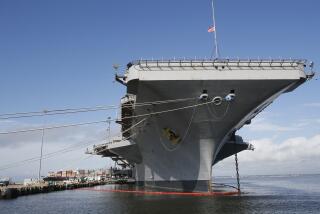Navy Considers Renewing Ties to Tailhook Group
- Share via
SAN DIEGO — Prodded by the chairman of the Senate Armed Services Committee, the Navy is considering whether to renew formal ties with the Tailhook Assn.--links the Navy severed amid a scandal over sexual harassment and drunken debauchery by aviators at the group’s 1991 convention in Las Vegas.
Officials of the San Diego-based group, whose goal is to promote carrier aviation, said they are encouraged by discussions with admirals assigned to prepare a report for the chief of naval operations, Adm. Jay Johnson.
There is even guarded optimism that a decision might be made soon enough for senior Navy and Marine Corps officers and their subordinates to attend Tailhook’s Aug. 19-22 convention in Sparks, Nevada, where the keynote speaker is astronaut Wally Schirra.
“I’m keeping some slots open on our agenda for active duty flags [admirals],” said Lonny McClung, the retired Navy captain who is Tailhook president.
McClung and other Tailhook officials believe that they can make a convincing case that the riotous behavior at the 1991 convention will never recur and that the Navy stands to benefit by welcoming Tailhook back.
According to a Navy spokesman, Johnson will review the admirals’ report and make a recommendation to Navy Secretary Richard Danzig. In a speech earlier this year to the Assn. of Naval Aviators, Danzig talked about the possibility of ending the estrangement between the Navy and Tailhook.
Sen. John Warner (R-Va.), chairman of the Armed Services Committee, has urged Danzig to “once again welcome the association as a member of the Navy-Marine Corps team.” Tailhook also has picked up support from Sen. Kay Bailey Hutchison (R-Texas).
In a letter to Danzig, Warner said he is pleased with the “corrective actions and conduct” of the Tailhook Assn. since the 1991 scandal and is confident that the group would be willing to “adhere to all Navy policies on standards of conduct.”
Asked about the movement toward restoring links, Republican presidential candidate John McCain, who had been the first senator to call for the Navy to cut ties with Tailhook, said he looks forward to hearing the views of Navy brass and of Secretary of Defense William Cohen. Like McCain, Cohen was in the Senate when the Tailhook scandal exploded.
“I see no reason why it should not be examined in light of the years that have passed,” the Arizona senator, a former Navy aviator and Vietnam prisoner of war, said after a Los Angeles speech this week. “But I’ve got to be honest with you--I’m not sure what changes they would make, [and] I just haven’t had time to examine it.”
The 1991 Tailhook scandal led to lawsuits, investigations, political furor in Washington and the resignation of Navy Secretary Lawrence Garrett. The careers of numerous aviators were damaged: 191 Navy officers and 21 Marine Corps officers were referred for punishment.
According to the Navy, 83 women, some in the Navy but mostly civilians, were assaulted at the convention. Tailhook settled a number of suits filed against it, including one by Lt. Paula Coughlin, an admiral’s aide and helicopter pilot whose complaints about lewd behavior by aviators led to the investigations. Coughlin, who left the Navy after reporting the scandal, also won a multimillion-dollar award from the Las Vegas Hilton. For several years after the 1991 convention, Congress demanded to be informed whenever a Navy or Marine Corps aviator who had attended was up for promotion.
In a case that outraged many aviators, a decorated fighter pilot from the Gulf War who was a leader of the elite Blue Angels had his promotion blocked by Congress, thus ending his career. This occurred despite the fact an investigation found no evidence of wrongdoing on his part.
In his speech this year, Danzig talked of the “trauma of Tailhook” and of what he sees as the Navy’s post-1991 success in integrating women into the ranks of front-line aviators.
“The whole relationship between the Navy and the Tailhook Assn. displeases me at the moment,” Danzig said. “The same sense of camaraderie that I’ve talked about makes it important for us to talk with one another and not to treat any portions of the [aviation] community as pariahs.”
As a political appointee, Danzig can be counted on to consider the political fallout from renewing a link to Tailhook.
Karen Johnson, a retired Air Force lieutenant colonel and now a vice president for the National Organization for Women, reacted cautiously to the possibility that the Navy might renew its link to Tailhook.
“Unless they have some obvious safeguards to keep this kind of behavior from reoccurring, I think the relationship should not be resumed,” Johnson said. “I’m all for professional conferences, but I suspect that some in the Navy might think this means it’s back to business as usual in terms of treating women with disrespect.”
In the wake of the scandal, the Tailhook Assn. settled the lawsuits against it, bought an office suite in a San Diego business park (after being booted out of then-Miramar Naval Air Station) and began to repair its image. “Our job was to prove that 1991 was an aberration,” McClung said.
After initially abandoning the group, aerospace companies have in recent years resumed sending representatives to the annual convention to discuss the latest in aviation hardware.
At its best, a Tailhook gathering is a chance for senior and junior officers to talk informally about the problems associated with supersonic aircraft and to bring their concerns directly to the manufacturers. There also is ample opportunity to swap war stories.
One of the most heavily attended seminars at last year’s convention, also in Sparks, concerned progress on the costly and controversial effort to develop a joint-strike fighter that can be used by the Air Force and Navy.
Although no active duty admirals were present--at least none who would acknowledge his presence to reporters--numerous junior officers attended last year’s convention on their own time. Recognition by the Navy could mean that officers could attend Tailhook conventions while on duty and possibly use military vehicles for transportation.
To make sure that any partying did not get raucous, convention planners spread hospitality suites among several floors to avoid a repeat of the combustive combination that led to the 1991 “gantlet” where women walking in a third-floor hallway of the Las Vegas Hilton hotel were pawed and mauled by drunken aviators.
*
Times political writer Cathleen Decker contributed to this story.
More to Read
Sign up for Essential California
The most important California stories and recommendations in your inbox every morning.
You may occasionally receive promotional content from the Los Angeles Times.













